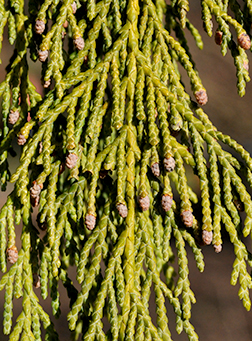 Virginia Tech Dendrology
Virginia Tech Dendrology
Alaska yellow-cedar Cupressaceae Callitropsis
nootkatensis (D. Don) Oerst. ex D.P. Little
![]()
![]() symbol: CANO9
symbol: CANO9
Leaf: Persistent, scale-like, and arranged in decussate pairs; yellow- to blue-green with no bloom on either surface; individual leaves are typically 1/16 to 1/8 inch long and diverge from the twig at their tips, giving a rough appearance and feel to the twigs. Foliage arranged in flat, drooping sprays, dead leaves fall in sprays.
Flower: Species is monoecious; male cones small and yellow to red; female cones small, round and bluish-green.
Fruit: Cones are small (about 1/4 inch diameter) and round, with smooth peltate scales with a distinct point on each; blue-green when young and brown when mature after 2 seasons
Twig: Distinctly flattened when young, but eventually round and often covered with dead sprays of foliage; branchlets are distinctly drooping.
Bark: Thin and shallowly ridged when mature; weathers to gray; young bark may be scaly.
Form: Medium sized evergreen trees that commonly reach 70 to 100 feet tall and 2 to 4 feet in diameter with a shaggy, conical crown of pendulous, frond-like branches.
Looks like: Leyland cypress
- western redcedar
- Port-Orford-cedar
- incense-cedar
Additional Range Information: Callitropsis nootkatensis is native to North America. Range may be expanded by planting. Download the full-size PDF map.
External Links: USDAFS Silvics of North America - USDAFS FEIS Silvics - USDA Plants Database - Horticulture Information - USDAFS Forest Products Lab
All material 2025 Virginia Tech Dept. of Forest Resources and Environmental Conservation; Photos and text by: John Seiler, Edward Jensen, Alex Niemiera, and John Peterson; Silvics reprinted from Ag Handbook 654; range map source information






